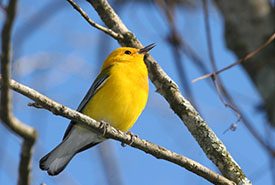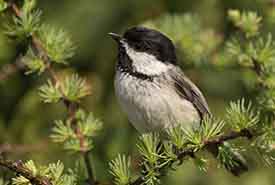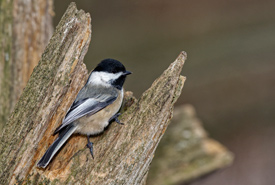NCC: Land Lines – Winter is for the birds

Prothonotary warbler (Photo by Bill Hubick)
When the temperature drops and fall colours give way to bare trees and snowy scenes, we tend to huddle up for the winter. Much like the natural world, we might prefer to take off to somewhere warm or hunker down indoors, to conserve our energy and to escape the cold. Gone is the summer, like the golden yellow of the prothonotary warbler, which is now foraging in the mangrove swamps of Central and South America.
But contrary to popular belief, winter is a great time to get outdoors and enjoy nature.
Hiking is one of my favourite winter activities, and I like to carry my binoculars around to spot birds toughing it out. Plus, birds are much easier to see up in the trees now that the leaves are gone. Sometimes I even bring out my tracking guide to check out the footprints left in the snow by mammals. This is a fun way to see what animals have been travelling through my favourite areas or even my backyard.

Black-capped chickadee at small wetland adjacent to NCC beach in Grand Manan (Photo by Nick Hawkins)
Since animals don’t have access to grocery stores that supply them with food year round, they have to find other ways to satisfy their appetites during the fruitless, winter months. Chipmunks and squirrels often stash their food for the winter, but did you know that birds do the same as well?
Black-capped chickadees stash seeds in nooks and crannies, also known as caches, all over the forest. These little birds travel in flocks around the forest, covering and stashing food across large areas. But how do they remember where all their food is? Squirrels are often forgetful, but black-capped chickadees have a trick to actually enlarge their brain capacity! During the fall, they increase the size of their memory to coincide with their caching activity, forgetting old memories to make room for new ones. This increase is a bit like cleaning out a space of unwanted clutter to make room for nice, new stuff. This memory increase will stick around through the winter months, helping the birds find all the goodies they stored in the fall. So with the clutter analogy in mind, it means you would need to retrieve all of your goodies from the spare closet before it disappears in the spring. This is a fair deal for black-capped chickadees, as there will be plenty more food to eat in the spring, so they can forget about their caches.

Black-capped chickadee (Photo by Lorne)
Now if only I could remember what I was going to say…oh, right! The Nature Conservancy of Canada (NCC) has plenty of properties that are accessible for hikes during the winter. Backus Woods in Ontario is a great place to get out and see wildlife. For those with accessibility needs, there’s a tour vehicle available, as long as you book ahead with the awesome NCC staff in Norfolk. Bring your binoculars and find a flock of curious black-capped chickadees. Their peeps are quite easy to distinguish in the forest, and they may even have some other friends nearby that you can spot, such as nuthatch, woodpecker, kinglet and creeper, that often hang out in their gang.
If this diversity of birds hasn’t convinced you to brave the cold, there are still ways to enjoy nature from home. Bird feeders are a great way to see some action from the comfort of your home, but make sure you can maintain feeding and cleaning it.
If you’re unable to house or maintain your own feeder, check out the Ontario FeederWatch cam to get your birding fix while sipping on some hot cocoa. Hope to see you out on the trails, having fun and being active in nature this winter!




